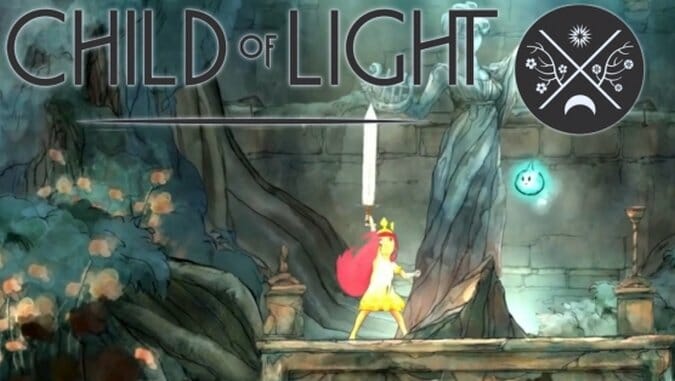Child of Light (Multi-Platform)

Ubisoft’s DLC, downloadable and hand-held games are some of the few places in major studio gaming where you can play as a scripted non-white-dude character. Child of Light casts you as the young daughter of an Austrian duke who, after the death of her mother and her father’s remarriage, has fallen into a deep slumber.
This happens over the Easter weekend, in case you needed some added significance. Otherwise, it’s fairly standard fairy-tale stuff: young girl, missing mother. Bruno Bettelheim built a career out of analyzing this type of thing.
I mean, it’s also literally a specific fairy tale. Maybe a bit too specific. This girl shares a name with Disney’s Sleeping Beauty. But this Aurora doesn’t lie in her magically-induced coma and wait for someone to kiss her out of it. She ventures through a beautifully-animated 2D world, called Lemuria, teaming up with others, and fighting monsters in JRPG-style turn-based battles. She’s also accompanied by Igniculus (she calls him “Sir Firefly” sometimes), a blue firefly controlled by the right thumbstick or a second player who aids in collecting and combat and puzzle solving through his ability to glow.
Lemuria is a children’s storybook, all hand drawn background and watercolor-washes. While the art really nails the aesthetic, the writing (at least, on a sentence-level) falls short.
Everyone speaks in rhyme. Well, the jester Rubella doesn’t. She (yes, she! there are multiple non-dude characters in this game!) uses a non-rhyming synonym for a word that would complete her couplet, much to the confusion of other characters. They fill in her rhymes.
It feels like it has aims toward poetry—or at least toward the kind of children’s book that uses verse to increase its impact. It stumbles when it comes to meter, though: There’s no rhythm to many of the lines, which is made more apparent during the occasionally-voice-narrated cutscenes. Lines like “for all intents and purposes, Aurora was dead” aren’t delivered as (or seemingly even meant to be) somewhat absurd punchlines or in an affectedly serious Lemony Snicket style.
The game is built on the UbiArt framework, Ubisoft’s 2D engine that we’ve seen in Rayman Origins and its sequel Rayman Legends. The games share a bit of their DNA, too. Rayman collected Lums, which would often burst out of a piece of the background and float in a line, encouraging the player to travel along a certain path. In Child of Light, Aurora and Igniculus can collect “wishes”, blue orbs that appear after being knocked out of glowing bushes. Like in Legends, running into these in the “correct” order (signaled by the change from blue to orange) gives you a bonus. Here, they explode into a cloud of green and purple orbs that refill Aurora’s health and magic meters.
Like her limbless counterpart, Aurora moves smoothly through her environments: Generally what you expect to happen on screen when you press a button happens. While Aurora’s ability to fly means her exploration is never full of complicated, split-second timing, environmental dangers like giant thorns can cause some pain. But where Rayman Origins and Rayman Legends threw their complexity into the platforming, Child of Light puts it in its combat system.
